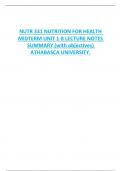NUTR 331 NUTRITION FOR HEALTH
MIDTERM UNIT 1-8 LECTURE NOTES
SUMMARY (with objectives)
ATHABASCA UNIVERSITY.
, lOMoAR cPSD| 19857451
Lesson 1 Notes
1. define nutrition.
a. nutrition the study of the nutrients and other biologically active compounds in
foods and in the body; sometimes also the study of human behaviors related to
food
2. discuss the nature of nutrients.
a. The six major classes of nutrients are carbohydrates, lipids (fats), protein,
vitamins, minerals, and water.
b. carbohydrates, lipids, proteins, and water are called macronutrients. The text
refers to carbohydrates, lipids, and proteins as energy-yielding nutrients (p. 5).
Vitamins and most minerals are required in smaller amounts (milligrams or
micrograms), so they are called micronutrients.
3. describe four methods of assessing nutritional status.
a. A nutritional history includes an assessment of the person’s diet.
i. many other aspects of the person’s history are recorded, including
medical history, particularly of diet-related conditions. (Examples include
alcoholism, anorexia, cancer, drug addiction, hypertension, liver disease,
pregnancy, and diabetes). Socioeconomic history is also important,
because it provides information about personal, financial, and
environmental influences on food intake. For example, a poor education
tends to influence the diet, as does living alone
b. anthropometric measures,
i. the physical characteristics of the body, such as height and weight. These
measures alert the assessor to serious problems such as growth failure in
children, wasting or swelling of body tissues in adults, and obesity—
conditions that reflect nutrient deficiencies or excesses.
c. physical examination that looks for clues to poor nutritional health status.
i. Various parts of the body can be inspected, particularly the hair, eyes,
skin, tongue, and fingernails; posture may also be assessed. A physical
examination can provide evidence of deficiencies, imbalances, and toxicity
status.
d. Laboratory Tests
i. A fourth way to detect a developing deficiency, imbalance, or toxic state is
to take samples of body fluids, such as blood or urine, and analyze them in
a laboratory. In the early stages of malnutrition, body changes may not be
obvious, but biochemical (laboratory) tests may reveal problems. A large
number of different biochemical tests are available, and it takes much
expertise to interpret their results. The most well-known of such tests is
blood hemoglobin, which indicates whether iron levels are in the normal
range.
ii. biochemical abnormalities shown by laboratory tests do not indicate
whether the cause is inadequate dietary intake (primary deficiency), or
something other than diet (secondary deficiency). Factors causing
secondary deficiency can include inefficient absorption and excessive
excretion (loss of the nutrient). The only way of confirming whether a
nutritional deficiency is dietary in origin is to do a dietary assessment.
4. describe four methods of diet information collection for nutritional analysis of
individuals or groups of people.
a. Diet History
i. This type of assessment is most commonly used by health professionals,
such as dieticians, to assess an individual’s eating habits or usual food
, lOMoAR cPSD| 19857451
intake. A diet history can reveal socioeconomic and cultural influences,
food intolerances, food likes and dislikes, seasonal variation in intakes,
appetite and taste changes, physical disabilities (chewing, swallowing,
mobility), shopping and cooking practices, and storage options such as
refrigerators and cupboards.
ii. A diet history is usually conducted along with one of the three other diet
assessment methods to determine nutrient intake for the total diet or to
assess specific nutrients. This type of history serves health professionals
well for planning healthy eating strategies with a patient or client to
encourage long-term changes.
iii. This method is rarely used in research studies because it is time
consuming, and consequently, too expensive
b. Food Diary
i. With this assessment, an individual keeps a diary with detailed
information about the foods eaten: type, amount, and method of
preparation.
c. Twenty-four-hour Food Recall
i. This method is commonly used in research studies to determine typical
food and nutrient intake. It is not a practical tool for assessing an
individual’s diet to determine potential nutritional deficiencies.
ii. A trained interviewer asks the subject to recall everything eaten or drunk
during the past 24 hours (or the previous day).
iii. Usually, food models and measurement aids are used to help the subject
estimate serving sizes more accurately.
d. Food Frequency
i. This method of assessing diets and nutrient intakes is widely used in
epidemiological studies (discussed in Unit 2). Such studies track the diet
consumption of a large group of people—hundreds, if not thousands, of
participants. The information tracked includes how often a particular food
or type of food is consumed during a specified period of time—day, week,
month, or year.
ii. A typical question for a food frequency is, “How often do you consume
broccoli?”
Note: Be sure that you are not confused between the assessment of nutritional status and
collecting diet information. Determining a person’s diet (and therefore their nutrient intake) is
only one component of determining their nutritional status.
5. explain the uses and limitations of food composition databases.
Food composition databases have two main uses:
1. They are a resource to determine the amounts of nutrients a person or a group of people
are consuming. A group may consist of people in a research study. A food composition
database could also be used to assess the nutritional value of a menu for a seniors’ lodge
or daycare.
2. They are used to identify foods which tend to be high or low in specific nutrients.
a. Several nutrients are not included in food composition tables (e.g., fatty acids and
trace minerals such as iodine).
b. Not all foods have been tested for all nutrients, so many have missing values. For
example, in Diet Analysis+ software, many fast foods are missing the B vitamins
and many minerals.




